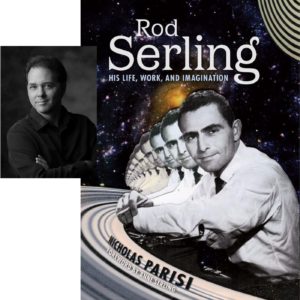Rod Serling and his work – “Rod Serling” (University Press of Mississippi, 2018) – Nicholas Parisi interview
Podcast: Play in new window | Download
Subscribe: Apple Podcasts | RSS
 Nicholas Parisi is a musician and vocalist and serves on the board of the Rod Serling Memorial Foundation. He’s recently written a book analyzing almost all of Rod Serling’s work and we discuss the book and Rod Serling’s works.
Nicholas Parisi is a musician and vocalist and serves on the board of the Rod Serling Memorial Foundation. He’s recently written a book analyzing almost all of Rod Serling’s work and we discuss the book and Rod Serling’s works.
1:39 – Nicholas talks about how he got into Rod Serling. He discusses many of the projects that Rod had been involved with. The book is part biography, part reference guide and part a critique of the themes that Rod explored in his work. It covers his entire writing life.
4:13 – Nicholas covers Rod’s radio work more extensively than other writers on Rod have.
5:58 – Nicholas talks about how Rod ended up in front of a screen in addition to being a writer.
6:45 – Nicholas talks about Orson Welles connection to the Twilight Zone and a myth surrounding it.
12:20 – Nicholas wants to emphasize that Rod was more than the Twilight Zone. He also mentions Rod’s attempts to put out scripts based on the Emmitt Till case.
17:16 – Rod’s daughter Anne Serling provided some support for this book.
24:43 – Nicholas’s book addresses a 1952 tv show episode that addressed racism most likely for the first time ever on television. Rod tried to push an episode addressing racism and no other researcher has talked about this episode before.
28:19 – Nicholas talks about Rod’s WWII experiences in the Philippines.
38:05 – Nicholas has a facebook for the book at facebook.com/RodSerlingDimensions
For more of “The Art and Design of Sci-Fi and Fantasy, Mystery and Horror” please follow me on Facebook at crisalvarezwlc, on youtube at Cris Alvarez and on Instagram @crisalvarezscifi
Guests: Nicholas Parisi
Host: Cris Alvarez
Tags: science fiction, sci-fi, rod serling, twilight zone, television, gold age, mystery, orson welles, Emmett Till, McCarthyism, racism, World War II, Philippines, US Army
 Dr. Sami Schalk is an academic who studies race, gender and disability in contemporary American literature and culture. We spoke about her latest book on science and speculative fiction as it relates to her studies.
Dr. Sami Schalk is an academic who studies race, gender and disability in contemporary American literature and culture. We spoke about her latest book on science and speculative fiction as it relates to her studies. Liz Denlinger co-curates the Shelley collection of the New York Public Library system. She has helped develop a new exhibition on Frankenstein and has put together a visual history of Frankenstein for it. We discuss the book and the exhibit.
Liz Denlinger co-curates the Shelley collection of the New York Public Library system. She has helped develop a new exhibition on Frankenstein and has put together a visual history of Frankenstein for it. We discuss the book and the exhibit.